 The Sheppard Subway Line A Look at Toronto's Newest Transit Tunnels - by Ninjalicious
An act of war? No, an act of creation! [The seemingly paradoxical relationship between construction and destruction, two concepts diametrically opposed yet mutually dependent, was first and best examined on the cartoon The Transformers, wherein six robot construction vehicles known as Constructicons merged together to form one giant robot known as Devastator. Devastator, it should be noted, was way cooler than Omega Supreme.] Toronto was preparing to give birth to its third subway line, and in preparation a series of wombs and tubes had to be put into place. Five mighty pits would be excavated across the line. Sometime before the end of the six-year gestation period, the five embryonic pits would develop into five strong subway stations linked by several long chains of square and tube tunnels. Like most Toronto subway stations, the new stations will be named after the roads they bisect: Yonge Street, Bayview Avenue, Bessarion Road, Leslie Street and Don Mills Road. Construction of the new 6.4-km line will cost an estimated $875 million, for a grand total of $137,000 per meter. Waiting until 2002 to peek in such fabulously ritzy tunnels was unthinkable, so I headed down to take an ultrasound.
Shifting my attention from the westernmost point on the line to the easternmost, I next fixated upon the vast construction site that sprawled across all four corners of the intersection at Don Mills and Sheppard. Scumbone and I left her car in the parking lot at the nearby Fairview Mall and began circling the well-barricaded perimeter in search of a subtle entrance. Failing to find one, we instead hopped through a largish viewing hole in a wooden barricade that read “Fairview Mall: Yours to Explore.” Immediately on the other side of the hole was a breathtaking pit (you really don’t see those two words used together often enough these days, do you?) that redefined my understanding of the term deep excavation. Beyond the half-meter of standing room around the perimeter, the hole plunged directly down approximately six storeys underground, where tiny-looking halogen lamps lit up the cement- and steel-coated underworld.
About this time, I spotted another cement tunnel about halfway up the pit wall that I wanted to investigate. There were no ladders handy, so I climbed up the yellow scaffolds to take a peek. It was just a short pedestrian tunnel under Sheppard — a little flooded and not incredibly interesting — so I climbed back down, making a fair amount of noise as I did so. I was just conveying to Scumbone my delight with the brand name of the scaffolds (Super Stud) when suddenly a distant voice yelled down at us, “What are you doing down there!” I scanned around the rim of the pit seven storeys above, spotted the guard and yelled back “Just lookin’ around, do you want us to leave?” He yelled back, “Do you want me to call the police!” I yelled back, “No, we’ll leave,” and Scumbone and I made our way out the same way we’d come in. I pouted as I applied my moist towelette. I had to wait a whole week before I got my next opportunity to head down into the Don Mills pit. After meeting up with Leftist and his friend Sara at Fairview Mall, I lead them to the oversized viewing hole I’d used the week before and coaxed them through. We descended the stairs to the bottom of the pit and I showed them around a bit. After peaking in on the blueprints, we continued to the west, crossing under the wooden boards supporting all the traffic on Don Mills seven storeys above. We came upon a large lake of wet cement, which we were able to circumvent without leaving tracks. The next hurdle was a vast, wet pit covered only by thin, crisscrossing metal bars. Sara and I tightrope-walked across these with relative ease, but the balance-impaired Leftist had quite a bit of trouble making it over. After the pit, we next entered a wide expanse of sand dunes and pits, and a fleet of small bulldozers and forklifts, which we somehow resisted using as bumper cars.
After another look at the TBM, I persuaded Leftist and Sara that we should walk down the tunnel towards Leslie. Our progress along the tracks was very slow, as the sloppy grey muck at our feet was quite deep, and there were no boards running along the side of the tunnel to make our journey easier. Earlier, we had decided we’d use standard tunneling excuse #4 (“I dropped my keys”) if we were caught inside the pit. Now that we were about $2,740,000 (20 meters) inside the tunnel, I mentioned to Leftist and Sara that excuse #4 probably wouldn’t be very helpful anymore. We’d travelled about $13,700,000 (100 meters) into the tunnel when Leftist declared that he needed a rest. While we waited, I thought I heard a voice off in the distance. Straining my eyes to see as far down the tunnel as possible, I thought I saw a vaguely humanoid figure wearing a hardhat, but I had to stare intently for several moments to determine that it was moving. I guess the worker felt my stare, because just then he started yelling at us, though we were so far away that I could barely hear his voice, let alone make out his words. I turned around to face Leftist and Sara, who were absorbed in conversation and hadn’t noticed the turn of events. In a voice that made it very clear I wasn’t joking, I said “I think we should make as hasty a retreat as possible.” I explained the details as we fled back up the tunnel. Sara was almost running along one rail, I was hopping from board to rail to board, and Leftist was simply trudging along through the shallow muck at the side of the tunnel. As we retreated, I took out my pocket flashlight and flashed it behind us three times, in the way that I’ve seen TTC workers do to one another when they spot each other from a distance inside the subway tunnels. I hoped this might confuse the workers enough to keep them from calling TTC security or the police. Before long we were back at the TBM. As I jumped out of the side of tunnel into the pit beyond, a loud voice came over a radio calling out in Spanish or Italian. Had the workers assumed we were co-workers because of the flashlight trick? There was no time to speculate. The three of us hopped onto a temporary orange staircase near the end of the pit and raced up seven storeys to the surface. We then crawled along a support beam and climbed through a wooden fence to step back on solid ground. No police cars or security vehicles seemed to be waiting for us, so we quickly exited through a gap in the fence and began to stroll along Sheppard, looking completely innocent aside from being coated in grey muck from the knees down. We strolled down the road to the Leslie construction site, where we admired the construction crew dumping huge vats of wet cement into the pit below, and did a little more Leslie-area reconnaissance before hopping on a bus and heading elsewhere.
It struck me as strange that the construction around Leslie and Sheppard, in the middle of the line, seemed to be so much more extensive than elsewhere. The gates and fences extended from far to the west of Leslie to far to the east, with multitudes of large pits, cranes and construction vehicles on both sides of Sheppard. It seemed that something special was happening at Leslie. Scumbone and I arrived late at night and started at the northeasternmost pit on the lot, easily rolling underneath a large gap under the chain link fence that surrounded the site. We made our way down the piles of crushed rock that surrounded the pit, and at the bottom found ourselves faced with one very large cavern dug into the earth, atop three much smaller cement tunnels that looked very much like storm drains. Some unpleasant-smelling water was being piped into one of these tunnels. We climbed up to investigate the cavern first, but found it didn’t go very far before ending at a large blue tarp. Climbing back down, we hopped into the middle of the three drain-like tunnels, and crouched down low to follow this muddy-bottomed tunnel for about 15 minutes before it spilled out on the south side of Sheppard into a deep, murky pool. We didn’t feel like swimming, so we groaned and made our way back out the way we’d entered. For our next trick, we crossed to the south side of Sheppard to look for any weaknesses in the tall chain-link fence around the perimeter of the main pit. We didn’t have to look hard at all, as there were quite a few places where it was easy to slide between two sections of fence that had been poorly linked together. We climbed down a couple of ladders and caught our first glimpse down at the brightly lit concrete chamber at the very bottom of the pit, which I assumed was the beginnings of Leslie Station. This looked to be the furthest-along section I’d peeked at so far, so I was quite excited as I started the descent down the long metal ladder. When I was about halfway down, though, I saw that the square tunnels stretched out of sight in either direction, and yelled “Wow!” louder than I should have. Unlike the sections to the west, the Leslie tunnels were very brightly lit with loudly humming halogen lamps. The tunnels were square, with smooth concrete ceilings, walls and (trackless) floors. There was a meter-wide concrete platform at the side of each tunnel, which seemed too narrow to be a passenger waiting area but too wide to be a platform for the workers. Maybe the TTC is working to make sure the new tunnels are accessible to wheelchair-bound infiltrators. We strolled first to the westernmost end of the excavation in one tunnel and then headed back to the east in the other. We also checked out an odd little pedestrian tunnel between the two future subway tunnels — a first in the Toronto rapid transit system, as far as I know. There weren’t that many exciting finds to break up the long walk, though I did stumble upon a safety vest left behind by a worker, which I tossed on as camouflage. After a long walk to the east, I spotted a flashing light in a section of tunnel far ahead. “That’s going to be something cool,” I mumbled aloud. Unfortunately, as we approached the flashing light, we came upon our first serious hurdle: a large, flooded, uncovered section separating our square tunnels from the tube tunnels with tracks ahead. The deep, black water filled with various construction materials jutting out of the muck at random angles seemed to us to be an impassable swamp. And yet… there were tube tunnels with tracks less than five minutes ahead of us! And that flashing light! We just had to get across! So, we did. Applying the skills I had learned from many years of playing Frogger, I climbed up onto a little wooden plank suspended a meter above the swamp, carefully crawled down the board to just above swamp-level, jumped from there onto a large pile of dirty snow, and swung myself from the pile of dirty snow up onto to the metal tracks extending out over the swamp. Scumbone followed my lead, and with the help of an extra bucket I found on the other side, made it across with only minimal flooding of her shoes. We carefully made our way along the tracks suspended above the swamp. 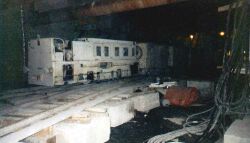 Our first stop on the other side was the flashing light, which turned out to be a warning light on the front of a big yellow construction train that ran along the subway tracks. I climbed up into the cab and asked Scumbone to take my picture, which she did, while making some snide comment about boys and trains. (Look: many boys may have an irrational love for trains, but hey, many girls have an irrational love for horses, and which of those do you think would win in a fight? I Rest My Case.)
Our first stop on the other side was the flashing light, which turned out to be a warning light on the front of a big yellow construction train that ran along the subway tracks. I climbed up into the cab and asked Scumbone to take my picture, which she did, while making some snide comment about boys and trains. (Look: many boys may have an irrational love for trains, but hey, many girls have an irrational love for horses, and which of those do you think would win in a fight? I Rest My Case.)That done, we proceeded along the tracks towards the tubes. One of the tubes looked to be filled with machinery and a bright blue glow, so I figured we’d save that for dessert and start with the one that seemed to stretch out into grey infinity. The tracks, as mentioned, were in place, but the entire floor of the tube was coated in sloppy grey muck. We walked along thick wooden boards that had been laid down beside the tracks, but these too were coated in slippery grey slop, so several times I just barely managed to catch my balance before falling over into a pile of the goop. We trudged up the tunnel for what seemed like an eternity, noting the remarkably unchanging nature of the décor: curved concrete slabs surrounding the diameter of the tunnel, a large sheet of clear plastic hanging from the ceiling, metal benches set in to the wall every $41,110,000 (30 meters) or so, and lots of lots of grey mush along the floor. A blue-green light at the end of the tunnel was all that motivated us to continue. Eventually, the light grew brighter, and was joined by a loud electrical hum. The tunnel also became much warmer. We realized we were coming up to the boring machine, the gigantic multi-million dollar automated drill that does all the dirty work of tunnel digging. The heat, we realized, was simply coming from the ten of thousands of volts of electricity flowing through the machinery. It seemed to me the air of the tunnel was also filled with electricity, so I did my best to avoid touching any metal as we made our way through the meters and meters of track-mounted machinery leading up to the drill itself. Once we reached the drill, I climbed up into the cramped cockpit to take pictures of the various buttons, levers, LED readings, computer displays and even the video screen that receives the signal from the camera mounted on the drill. I was both thrilled and intensely nervous to be here — I was very worried I would accidentally hit some lever in the cramped little control room and send the machine roaring to life. A flashing display reading “ALARM 2 ALARM 2 ALARM 2” was also a little disconcerting, but I figured this probably wasn’t a motion detector, but rather that the crew had just decided to call it a day when they’d hit a roadblock. We made the long journey back down the tunnel. For a bit we were convinced that a humanoid figure was staring at us from the end of the tunnel, but as we got closer it became obvious that it was actually just a propane tank with a lot of personality. We only had to make a cursory inspection of the blue-lit tunnel to determine that this was simply a slightly different model of boring machine that hadn’t yet made much progress down the tunnel. By now, it was about 1:30a.m. and we’d spent most of the night climbing around tunnels, so we ascended to the surface and made our way out of the site.
Leslie III: Leslie With a Vengeance A full article on the building of the Sheppard Subway Line appeared in Infiltration 13 (May 1999), together with articles on the construction of Festival Hall and how to prepare for infiltrating construction sites.
|
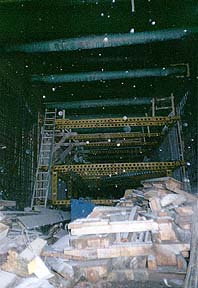 My First Subway Pit
My First Subway Pit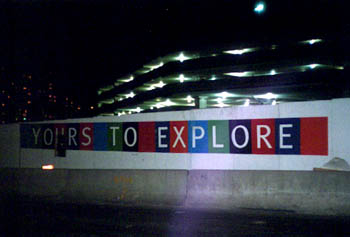
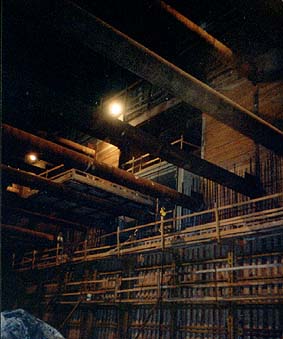
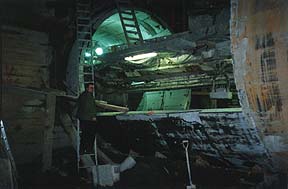
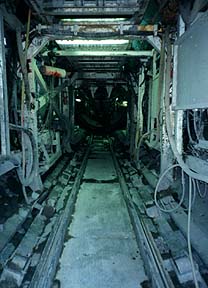
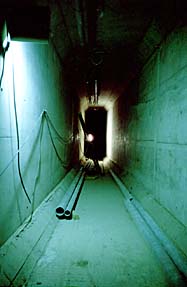
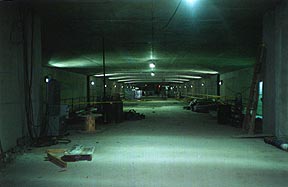 Leslie II: Leslier
Leslie II: Leslier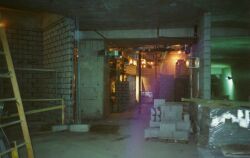 We wandered the length of the platform quietly, as we weren't sure if the area we were in connected to the area where the construction crew was working. The tunnels didn't seem to extend beyond the station, which meant no access to the tube tunnels. Lifting up a manhole in the floor, I climbed down a short ladder into a dark crawlspace under the platform that seemed to extend across the entire length of the station.
We wandered the length of the platform quietly, as we weren't sure if the area we were in connected to the area where the construction crew was working. The tunnels didn't seem to extend beyond the station, which meant no access to the tube tunnels. Lifting up a manhole in the floor, I climbed down a short ladder into a dark crawlspace under the platform that seemed to extend across the entire length of the station.